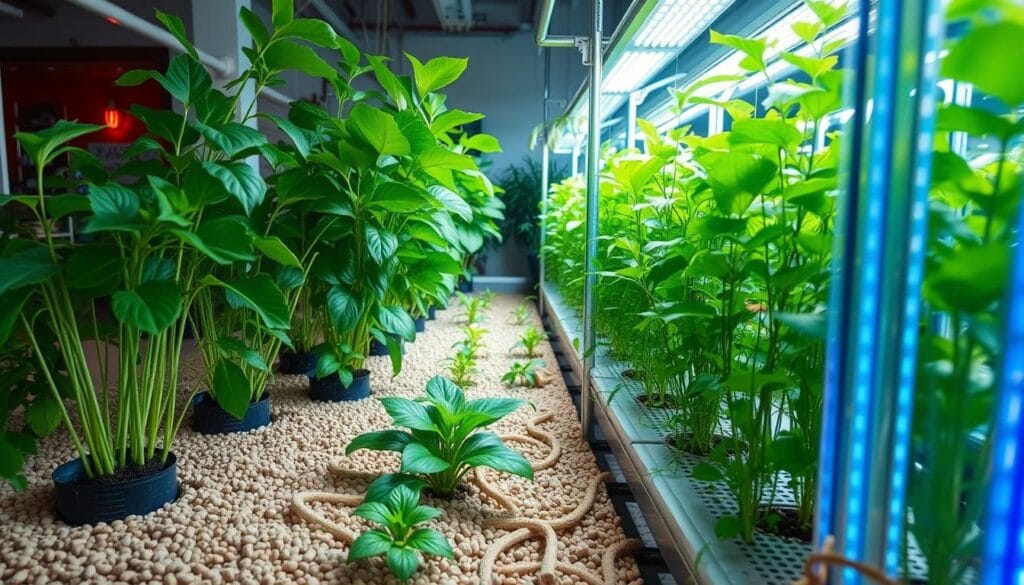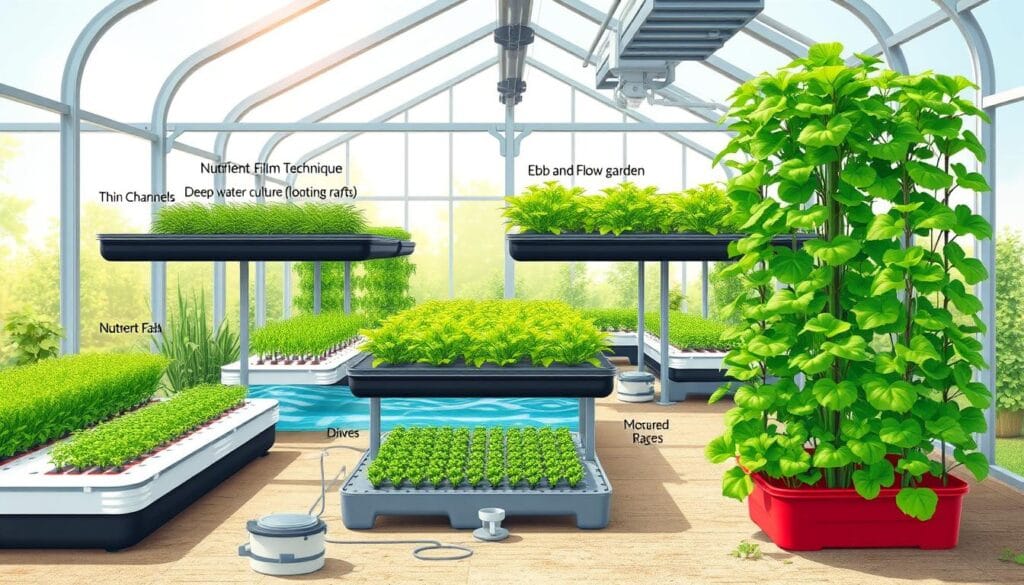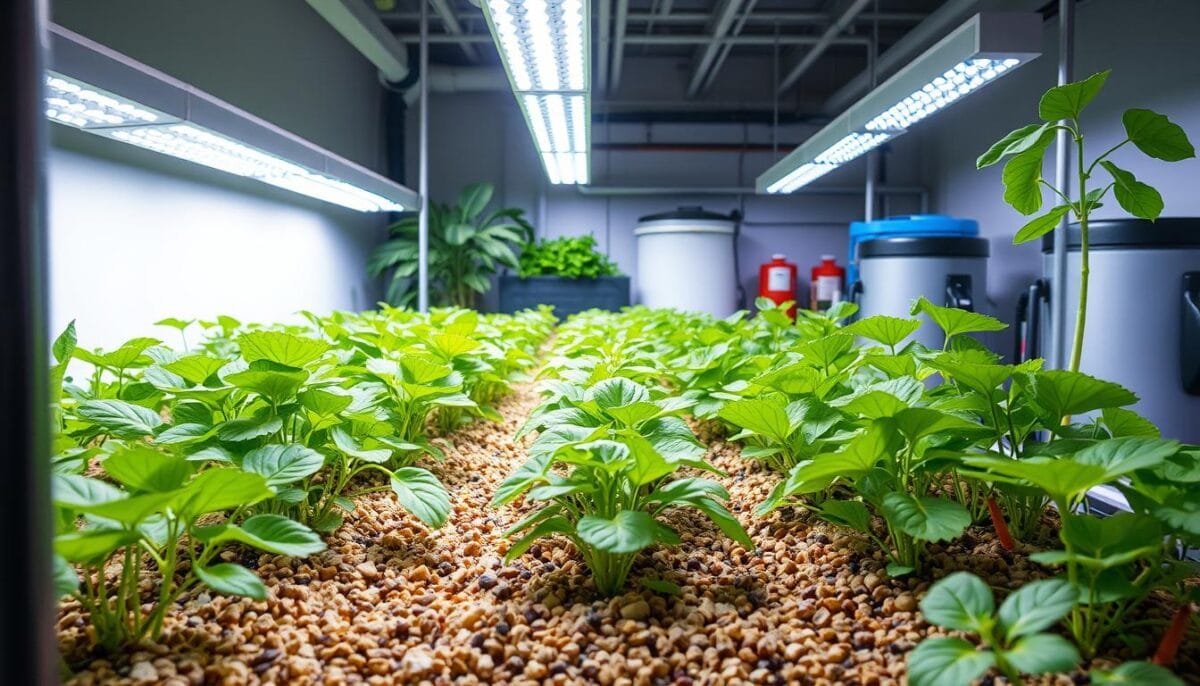Hydroponic Growing Medium is a key component in the success of hydroponic gardening.
Hydroponic is a new way to grow plants without soil. It uses water and nutrients to grow many types of crops. This method is popular among gardeners and commercial growers because it has many benefits over growing in soil.
The growing medium is key in a hydroponic system. It supports the plants and helps them get the nutrients they need. This guide will cover the different types of hydroponic growing media. It will also talk about their unique features and how to pick the best one for your indoor garden.
Whether you’re already into hydroponics or just starting, knowing about the growing medium is important. It will help you grow healthy, thriving plants.
Key Takeaways
- Hydroponic growing offers the advantage of using water and nutrients more efficiently, reducing waste.
- Hydroponic systems promote healthier plants by keeping roots free of soil-borne diseases.
- Substrate growing systems, a variant of hydroponics, provide enhanced control over root conditions.
- Proper nutrition is crucial in hydroponic growing, with plants requiring essential macro- and micronutrients.
- Hydroponic systems use up to 90% less water than conventional gardening methods.
Introduction to Hydroponic Growing
What is Hydroponics?
Hydroponics is a way to grow plants without using soil. Instead, plants get their nutrients from a special water solution. This method lets you control the growing environment closely.
As a result, plants grow faster and produce more than they would in soil. This is because you can adjust the water solution to meet their needs exactly.
Benefits of Hydroponic Cultivation
Hydroponic gardening has many benefits. You can grow plants indoors all year round. This means you can avoid pests and diseases that outdoor gardens often face.
Hydroponic systems also use much less water than traditional gardens. The water is constantly recycled, making it very efficient. Plus, you can stack these systems vertically to save space and grow more plants.
Hydroponic plants can grow up to 5 times faster than those in soil. This is because the water solution is always available and perfectly balanced.
Hydroponics is also very energy-efficient. LED light bulbs used in hydroponic systems are cost-effective to operate for 12-16 hours a day. This is great for saving money and being kind to the environment, especially in cities with little space.
Whether you’re new to gardening or have been doing it for years, hydroponics is worth trying. It’s perfect for growing a variety of crops, from leafy greens to colorful flowers.

Types of Hydroponic Systems
Hydroponic gardening has many system types, each with its own benefits. They can be divided into static and continuous flow systems. Knowing the differences helps you pick the right hydroponic system for your needs.
Static Hydroponic Systems
Static systems, like Deep Water Culture (DWC) and Wick Systems, are easy to start with. In DWC, roots soak in a nutrient-rich solution. Wick systems use a material to keep delivering water and nutrients to roots.
Continuous Flow Hydroponic Systems
For more control and efficiency, choose continuous flow systems. These include Aeroponics, Drip Systems, Ebb and Flow, and Nutrient Film Technique (NFT). Aeroponics mist roots with water and nutrients. Drip Systems deliver water and nutrients right to the roots. Ebb and Flow systems flood and drain roots for aeration. NFT systems keep a constant flow of solution over roots.
Every hydroponic system has its own benefits. Understanding these helps you choose the best one for your gardening goals.

Essential Components of a Hydroponic System
Starting a hydroponic garden needs several key parts. At its core, a hydroponic setup has hydroponic system components. These parts give plants the nutrients, oxygen, and support they need to grow well.
The main parts of a hydroponic system are:
- A reservoir to hold the nutrient-rich water solution
- A water pump to move the solution around the system
- A growing medium, like perlite or coco coir, to support and moisten the roots
- A balanced nutrient solution with the right mix of nutrients for plants
- A pH testing kit to keep the solution’s pH just right for nutrient uptake
- Grow lights for indoor setups to help plants make food through photosynthesis
- An air pump and air stone to add oxygen and prevent root rot
Choosing and combining these hydroponic setup parts is key. It ensures plants get what they need for healthy growth and plenty of harvests.
Quality hydroponic equipment and a balanced system unlock hydroponic gardening’s full potential. It’s a green and efficient way to grow many plants, from greens to flowers.
Suitable Plants for Hydroponic Growing
Hydroponic gardening is very versatile. Many plants do well without soil. You can grow everything from vegetables and herbs to flowers and ornamentals.
Vegetables and Herbs
Hydroponic systems are great for growing vegetables and herbs. Tomatoes, peppers, and cucumbers love it. Leafy greens like lettuce and kale do well too.
Herbs like basil and mint also thrive. This method can grow a lot of food in a small space. For example, 1.5 acres can produce 2.7 million servings of leafy greens a year.
Leafy greens can stay fresh for 10-14 days in the fridge. This means you can enjoy a long harvest.
Flowers and Ornamentals
Hydroponics aren’t just for food. You can also grow beautiful flowers and ornamentals. Carnations, gerbera daisies, and orchids are just a few examples.
These plants add beauty to your indoor garden. They also grow faster and use less water. This makes them a great choice for hydroponics.
Hydroponic gardening means growing plants in water. This leads to faster growth and less trouble with pests. But, it does need regular care to keep everything healthy.
When picking plants for your hydroponic garden, think about what they need. Make sure they fit with your system. This way, you can have a beautiful and productive indoor garden.
Starting a Hydroponic Garden at Home
If you’re curious about how to start hydroponic gardening, you have two choices. You can either build a DIY hydroponic system or buy a pre-made kit. Building your own DIY hydroponic systems is cost-effective and lets you customize it. You can use materials like buckets, PVC pipes, or the Kratky method.
On the other hand, pre-made hydroponic systems are convenient and reliable. They come in various sizes, from countertop to large-scale setups, and even vertical gardens.
DIY Hydroponic Gardens
Building your own hydroponic gardening setup lets you get creative and try new things. You can use simple items like plastic containers, air pumps, and growing media. This is great for hydroponic gardening for beginners because you can make it fit your space and needs.
Pre-Made Hydroponic Systems
If you prefer an easier option, pre-made hydroponic kits are a good choice. These kits have everything you need, like growing trays, water pumps, and nutrient solutions. They make it easier to start and reduce mistakes. Although they cost more upfront, they’re perfect for beginners.
Starting a hydroponic garden at home is rewarding and sustainable. It lets you grow fresh produce all year, even in small indoor spaces.
Nutrient Management in Hydroponics
Managing nutrients is key to growing plants well in hydroponics. Plants need 17 essential elements for growth. These are split into macronutrients and micronutrients. Commercial solutions have all these in the right amounts.
Essential Nutrients for Plant Growth
Hydroponic systems use nutrient solutions to feed plants. There are three main ways to do this: fertilizer programs, recipes, and complete fertilizers. Fertilizer programs like Hydro-Gardens Chem-Gro tomato formula are easy to use. Recipes, like the Modified Sonneveld Solution for herbs, give plants the nutrients they need.
Maintaining Proper pH and EC Levels
Keeping pH and electrical conductivity (EC) levels right is vital. pH should be between 5.5 and 6.5 for best nutrient absorption. EC shows how much salt is in the solution. Checking and adjusting these levels keeps plants healthy and productive.
“Nutrient solutions can be provided at normal strength or concentrated (50-, 100-, or 200-times normal strength) based on injector capabilities and fertilizer solubilities.”
Advantages and Challenges of Hydroponic Growing
Hydroponic gardening is a new way to grow plants without soil. It offers many benefits for both big farms and home gardens. These include better water efficiency, higher yield, and space-saving options.
One big plus of hydroponics is how little water it uses. Hydroponic farms can save up to 90% of water compared to traditional farming. This is ideal for areas with limited water availability.
Hydroponics also helps plants grow faster and stronger. Plants grown in hydroponics can be 16 times denser than those in soil. Hydroponic farms can have up to 18 harvests a year, while soil farms have about 3.
Another benefit is how little space hydroponics needs. For example, Flex Farms use just 9 square feet to grow 25 pounds of lettuce every 28 days. This is perfect for growing in cities or small areas.
But, hydroponics also has its challenges. Starting up can cost more than traditional gardening. The systems need regular maintenance and monitoring to work well. Also, keeping pests and diseases away can be harder in hydroponics.
To succeed with hydroponics, you need to know the challenges and how to overcome them. By understanding the pros and cons, growers can make the most of this new way of farming. They can enjoy a sustainable, productive, and space-efficient growing system.
“Hydroponic farming can yield up to 18 harvests per year compared to the average 3 harvests from soil farming.”
Hydroponic Growing Medium
The hydroponic growing medium is key for your plants. It supports them and helps nutrients reach them well. When picking a medium, think about its water-holding, aeration, and pH levels. Let’s look at the different types and how to pick the best one for you.
Types of Growing Media
Here are some common hydroponic growing media:
- Rockwool: A mineral-based substrate that provides excellent aeration and water-holding capacity. It’s widely used in hydroponic systems due to its ability to support plant roots and maintain optimal moisture levels.
- Perlite: A lightweight, volcanic-based material that excels at aeration and drainage. Perlite is often combined with other media to improve overall substrate structure and air circulation.
- Vermiculite: A mica-based material that absorbs and retains water well, making it an excellent choice for hydroponic systems that require consistent moisture levels.
- Coco coir: Derived from coconut husks, coco coir offers superior water-holding capacity and aeration, while also maintaining a neutral pH, making it a popular option for hydroponic gardeners.
Choosing the Right Medium
When picking a hydroponic growing medium, think about your plants’ needs and your system. For example, a deep water culture (DWC) system may need a highly aerated medium like perlite. On the other hand, a nutrient film technique (NFT) system might do better with a medium that holds moisture, like coco coir. By choosing the right medium, you can create the best environment for your plants to grow in your hydroponic garden.
Plant Maintenance in Hydroponic Systems
Keeping your hydroponic garden healthy is key. Watch for signs of nutrient problems and fix the solution quickly. It’s also important to keep the pH and EC levels right. This ensures your plants get the nutrients they need to grow well.
Sticking to a routine helps your hydroponic garden last longer and work better. For example, a clean hydroponic system uses up to 90% less water than traditional farming. This makes it a great choice for saving water and being kind to the planet.
Here are some tips to keep your hydroponic plants happy:
- Check pH and EC levels often, aiming for a pH of 5.5-6.5 and the right EC for your plants.
- Clean the system, including the reservoir, tubing, and trays, every month. This stops salt and organic matter from building up.
- Change the growing medium every 6-12 months. This keeps nutrients flowing and prevents diseases.
- Look over the water pump and other parts regularly. Make sure they’re working right to keep nutrients moving and avoid clogs.
- Deep clean the whole system at the end of each growing season. This gets it ready for the next cycle.
By keeping up with maintenance, you’ll make your hydroponic system last longer and work better. Hydroponics are great for growing plants fast, getting more food, and using less water. It’s a favorite among gardeners at home and in businesses.
| Hydroponic Maintenance Schedule | Frequency |
|---|---|
| Check pH and EC levels | Weekly |
| Clean reservoir and tubing | Monthly |
| Replace growing medium | Every 6-12 months |
| Inspect and maintain water pump | Monthly |
| Perform end-of-season deep cleaning | Annually |
“Hydroponic systems are designed to provide a maximum yield with minimum effort.”
Troubleshooting Common Hydroponic Issues
Keeping your hydroponic garden healthy means watching it closely and fixing problems fast. You might face issues like nutrient imbalances, pH changes, root rot, or system failures. Knowing how to solve these problems helps your garden stay healthy and productive.
System leaks are a big problem in hydroponics. They can cause water to spill over and back up in the reservoir. Look for leaks at joints or valves often. Fixing these issues quickly is key to avoiding problems.
Lighting is also very important. If your plants don’t get enough or the right kind of light, they won’t grow well. Use LED or T5 grow lights. Make sure they give about 65 watts of light for every square foot of plants.
Choosing the right nutrients is crucial. The wrong fertilizer can harm your plants. Use nutrients made for hydroponics. Keep an eye on pH and nutrient levels to keep everything balanced.
Pests and diseases can be tough to deal with. Use strategies like introducing beneficial microbes, like Hydroguard. Also, keep the air moving and humidity levels right to stop pests and diseases.
By tackling these common problems, you can make your hydroponic garden a success. Always check your system, look for advice, and learn from others. This way, you can fix any issues that come up.
“Achieving success in hydroponic gardening relies on effective problem-solving and a commitment to ongoing learning. With the right knowledge and a proactive approach, you can overcome any hurdle and enjoy a thriving, productive hydroponic setup.”
Conclusion
Hydroponic gardening is a smart way to grow many plants, like veggies, herbs, flowers, and more. It saves water, boosts yields, and fights pests and diseases. This method lets gardeners enjoy a lush garden indoors or outdoors.
Building a DIY system or buying a ready-made one is up to you. Knowing the basics, like nutrients and plant care, is crucial for a good hydroponic garden.
Hydroponic growing opens up a world of fresh food and lovely flowers. It offers control over the environment, uses less water, grows plants faster, and cuts down on pesticides. It’s great for both new and seasoned gardeners starting hydroponic gardening.
Keep exploring hydroponic gardening to make a green, efficient, and fruitful space. With the right skills and effort, you can make the most of this method. Enjoy a thriving, self-sufficient garden all year.

